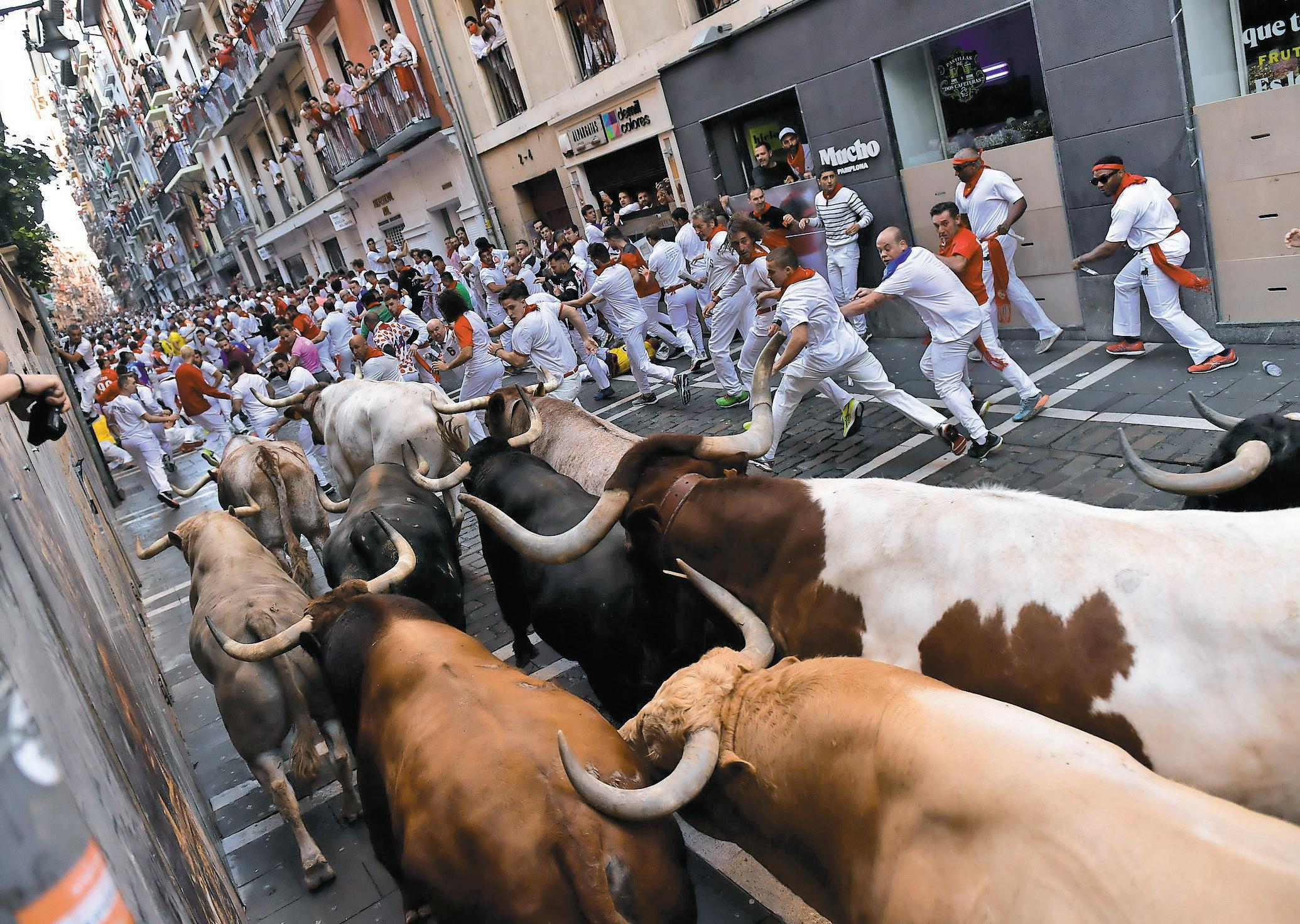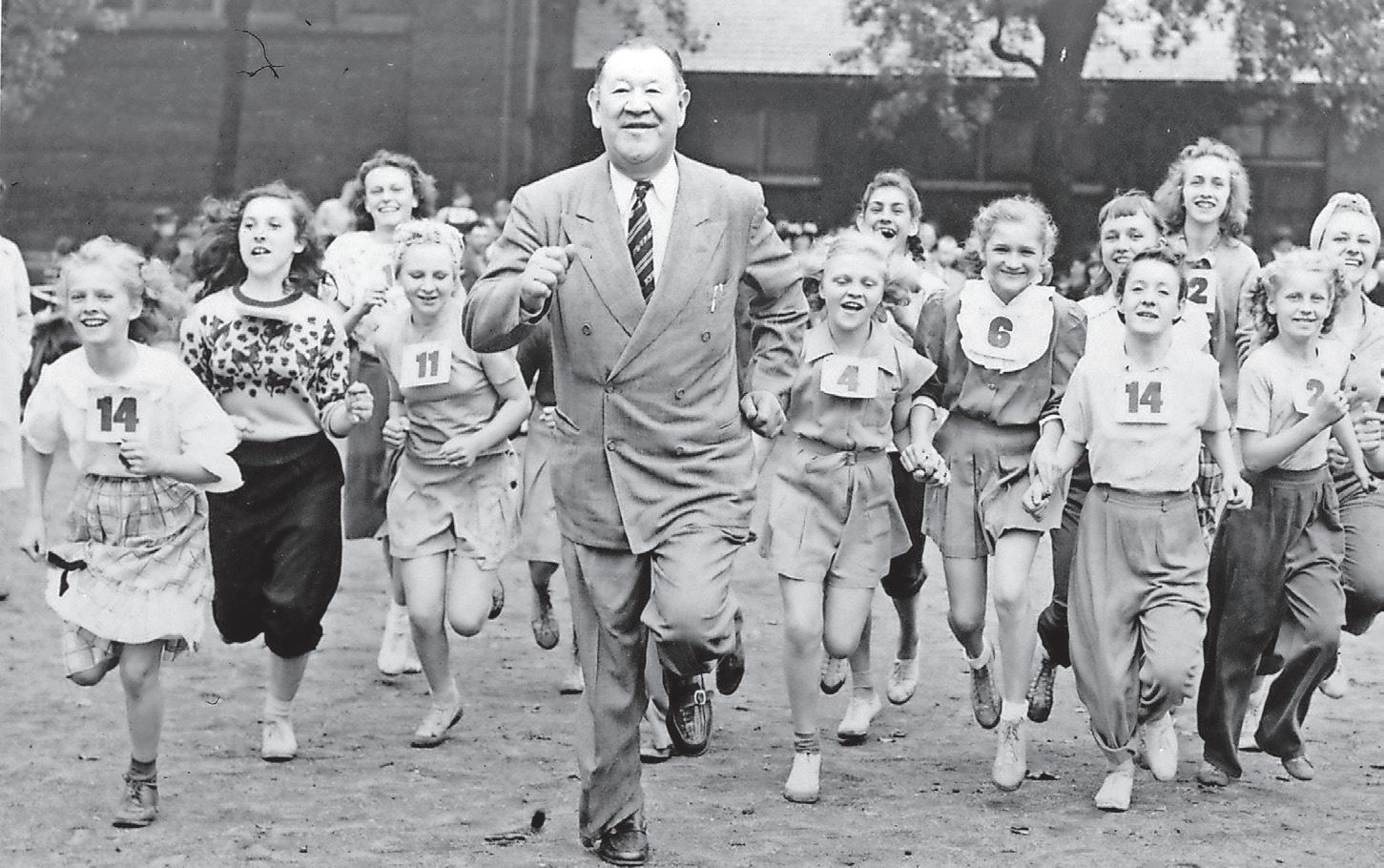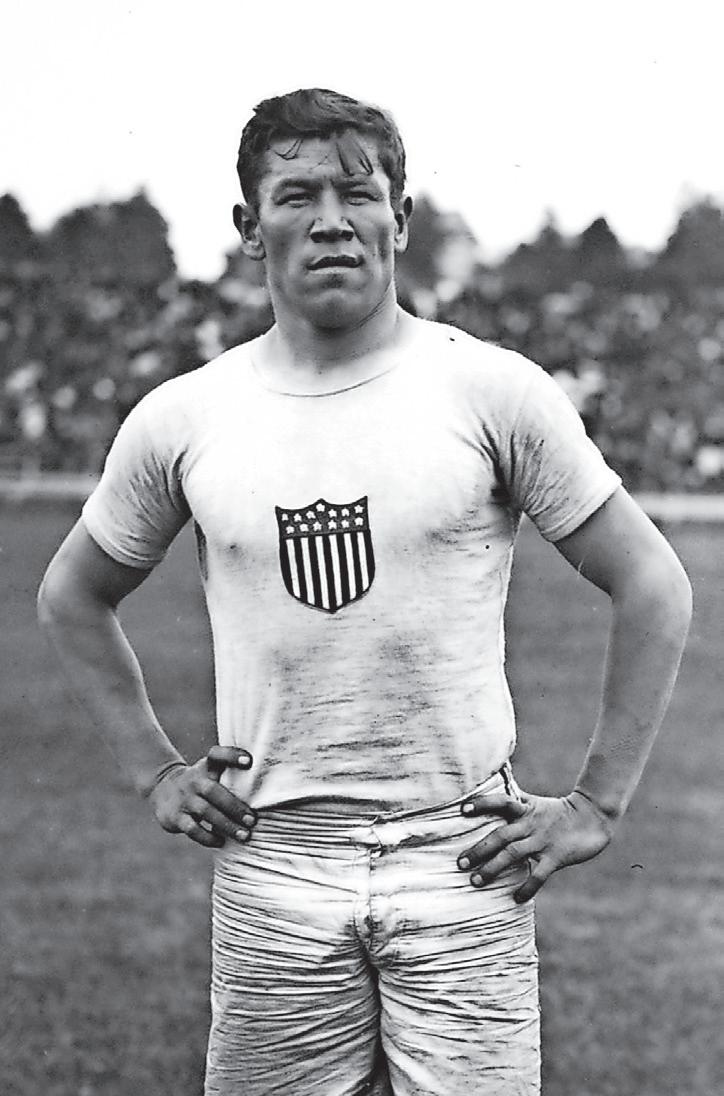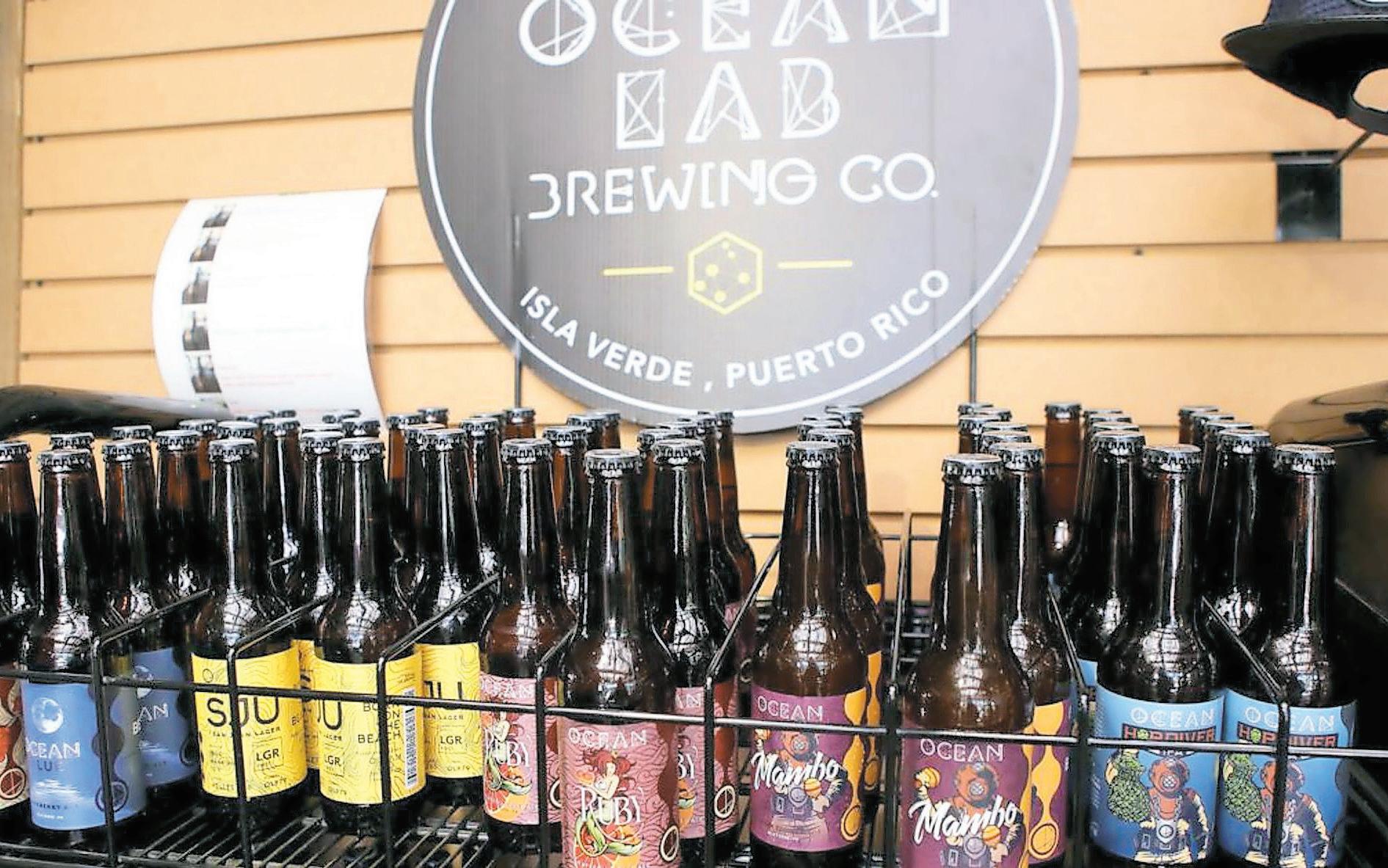
10 minute read
The running of The bulls is baCk
Spain´s bull runs return with thrills, emotion
Advertisement
Álvaro Barrientos and Ciarán Giles –The Associated Press
PAMPLONA, Spain (AP) — Pamplona was once again a sea of red and white as the frenzied madness of the San Fermín running of the bulls festival returns with adrenaline, emotion and passion following a two-year suspension because of the coronavirus pandemic.
From the start on July 6, the tension and excitement was palpable.
Tens of thousands of people donning the customary white trousers and shirt with red sash and neckerchief packed the town hall square for the traditional “chupinazo” firework that kicks off the nine-day San Fermín festival.
After that, it was a nonstop party, spiced up with the electrifying running of the bulls each morning at 8:00 a.m.
The festival reunited friends and families from all over.
Joe Distler, 70, from New York, has been coming and running for the past 50 years but says he was sad to miss the past two editions.
“It´s incredible. Two years without Pamplona was very, very bad,” he said, speaking in Spanish. “How lucky to be with friends here this year in Pamplona. Fabulous. Hopefully next year there will be no more COVID.”
Pamplona’s population of around 200,000 bloats to nearly a million during San Fermín. For many foreigners, especially Americans, Australians and Britons, it´s a “bucket list” thing they have to do.
“It´s amazing atmosphere, amazing people, amazing opportunity to celebrate. We love it here,” said 21-year-old Harvey Miller, of
Philadelphia, who was making his first trip with his sisters, Ashlei, 30, and Kayla, 23.
“I think people are trying to make up for lost time because two years off, that´s a while,” Miller said. “So, everyone is going extra hard this time around and the festival is bigger and better than ever.” They, like many, also know of the festival from Ernest Hemingway’s 1926 novel “The Sun Also Rises,” which is deemed to have made it internationally famous. Martín Chozas, 76, from Spain was also a first timer. ¨This is like going to heaven,” said Chozas, adding that he felt “the shivers” when he arrived. He planned to stay “as long as the body puts up with it.”
The festival highlight is undoubtedly the morning “encierros,” or runs, that see hundreds of people of all ages — mostly men — testing their agility and bravery to run like mad with six fighting bulls and their guiding steer along an 875-meter (956-yard) route to Pamplona’s bullring, where later in the day the bulls are
killed by professional bullfighters. People watch the run from balconies, doorways and street barriers as well on It´s incredible…How lucky to be television and the internet. On the fringes, there is a wealth of great with friends here this year in restaurants and tapas bars, while street bands, Pamplona. Joe Distler, 50 years running spontaneous parties and shows for children all go to place it among the most popular festivals with the bulls in the world. Gorings, meanwhile, are a feature everyone braces for but hopes they won´t occur. In the seven runs held till last Wednesday, there were just four gorings, none serious. In general, the bulls seemed content to ignore the
In fact, runners unless they are provoked or teased. Eight people were gored during the last festival in 2019. Sixteen people have died in the Hundreds of bull runs since 1910. The last death occurred in people of all ages 2009. test their agility and The response to injuries during the runs is bravery running like quick. People can be treated directly by Spanish mad with six fighting Red Cross medics or in the bullring surgery area. bulls. Many don’t end up having to be taken to a city hospital. Pamplonians and visitors packed the town hall square at midnight last Thursday to sing the mournful “Poor Me” (Pobre de mi) traditional balad that bids goodbye to the festival before singing the rousing “First of January” (Uno de enero), the jaunty song that looks ahead to the festival the following year. Before the pandemic, the festival was last suspended during the Spanish Civil War in the 1930s.
People run through the streets with fighting bulls and steers during the first day of the running of the bulls at the San Fermín festival in Pamplona, northern Spain. >AP Photo/Alvaro Barrientos, File

Big Jim Thorpe, famed American athlete and former U.S. Olympic great, has been reinstated as the sole winner of the 1912 Olympic pentathlon and decathlon — nearly 110 years after being stripped of those gold medals for violations of strict amateurism rules of the time. >AP Photo, File
Jim Thorpe reinstated as sole winner for 1912 Olympic golds
The Associated Press
LAUSANNE, Switzerland (AP) — Jim Thorpe has been reinstated as the sole winner of the 1912 Olympic pentathlon and decathlon in Stockholm — nearly 110 years after being stripped of those gold medals for violations of strict amateurism rules of the time.
The International Olympic Committee announced the change last Friday on the 110th anniversary of Thorpe winning the decathlon and later being proclaimed by King Gustav V of Sweden as “the greatest athlete in the world.”
Thorpe, a Native American, returned to a ticker-tape parade in New York, but months later it was discovered he had been paid to play minor league baseball over two summers, an infringement of the Olympic amateurism rules. He was stripped of his gold medals in what was described as the first major international sports scandal.
To some, Thorpe remains the greatest allaround athlete ever. He was voted as the Associated Press’ Athlete of the Half Century in a poll in 1950.
In 1982 — 29 years after Thorpe’s death — the IOC gave duplicate gold medals to his family but his Olympic records were not reinstated, nor was his status as the sole gold medalist of the two events.
Two years ago, a Bright Path Strong petition advocated declaring Thorpe the outright winner of the pentathlon and decathlon in 1912. The IOC had listed him as a co-champion in the official record book.
“We welcome the fact that, thanks to the great engagement of Bright Path Strong, a solution could be found,” IOC President Thomas Bach said. “This is a most exceptional and unique situation, which has been addressed by an extraordinary gesture of fair play from the National Olympic Committees concerned.”
Thorpe’s Native American name, Wa-Tho-Huk, means “Bright Path.” The organization with the help of IOC member Anita DeFrantz had contacted the Swedish Olympic Committee and the family of Hugo Wieslander, who had been elevated to decathlon gold medalist in 1913. “They confirmed that Wieslander himself had never accepted the Olympic gold medal allocated to him, and had always been of the opinion that Jim Thorpe was the sole legitimate Olympic gold medalist,” the IOC said, adding that the Swedish Olympic Committee agreed.
“The same declaration was received from the Norwegian Olympic and Paralympic Committee and Confederation of Sports, whose athlete, Ferdinand Bie, was named as the gold medalist when Thorpe was stripped of the pentathlon title,” the IOC said.
Bie will be listed as the silver medalist in the pentathlon, and Wieslander with silver in the decathlon. World Athletics, the governing body of track and field, has also agreed to amend its records, the IOC said. Bright Path Strong commended the IOC for “setting the record straight” about the Sac and Fox and Potawatomi athlete. “We are so grateful this nearly 110-year-old injustice has finally been corrected, and there is no confusion about the most remarkable athlete in history,” said Nedra Darling, the organization co-founder
In fact, and citizen of the Prairie Band Potawatomi Nation. At world championships Thorpe had been stripped of his Olympic gold medals for violations of strict amateurism rules of the time. in Eugene, Oregon, Native American hammer thrower Janee’ Kassanavoid said the announcement was news to celebrate. “My ultimate goal is to follow in his footsteps, to inspire and empower the next generation of athletes to come,” she said. Jim Thorpe at the 1912 Summer Olympics. (Public domain USA) As the first Native American to win an Olympic gold medal for the United States, Thorpe “has inspired our people for generations,” said Fawn Sharp, president of the National Congress of American Indians. In Stockholm, Thorpe tripled the score of his nearest competitor in the pentathlon and had 688 more points than the second-placed finisher in the decathlon. During the closing ceremony, King Gustav V told Thorpe: “Sir, you are the greatest athlete in the world.”

Ocean Lab wins Craft Beer Marketing Award
Madison Choudhry, Special to The Weekly Journal
Although Puerto Rico is known for its rums, beer tends to take the center stage at social gatherings. With options that range from local to international to domestic, a growing interest for craft beer has recently emerged. So much so that Travel & Leisure magazine named Puerto Rico “the new craft beer capital of the Caribbean.”
In that context, the Craft Beer Marketing Awards (CBMAs) has recently awarded Ocean Lab Brewing Co., a local brewery “dedicated to help amplify the palate of those who opt for more than just a generic light beer” with the Best Bottle Design for their Mayawest lager.

Luis Fernández, owner Ocean Lab Brewery Co.
The CBMAs is a worldwide competition which focuses specifically on celebrating excellence in artistic and creative marketing. In addition, it takes into account the packaging efforts of breweries, designers and different agencies of craft beer. The award itself is designed to depict a heavily–tattooed arm crushing a beer can to symbolically represent how breweries are “crushing it” with their creative beer marketing and branding.
“The CBMAs accepted entries from around the globe from five regions. A total of 250 awards were presented to winning brewers, designers, and marketing agencies from throughout the world. This year there were 89 Platinum winners, 135 Gold winners and 26 Global winners,” reads the CBMAs website. Ocean Lab was one of those 26 Global winners.
“This is a very interesting community. There is a lot of interest, and the experience that we offer to consumers, speaking directly with the brew master and the people in charge of production is completely unique. You can’t find that in many places, and we want to In fact, give that to the Puerto Rican people,” said Ocean Lab owner Luis Fernández. A total of 250 awards
“We were very impressed by were presented to the sheer creativity, innovation, winning brewers, and caliber of marketing designers, and displayed in entries from around marketing agencies the world in every category,” from throughout the CBMAs Co-Founder Jim McCune world. said. “More than 500 judges from around the world had their work cut out for them this year… they really had to split hairs!” Notable for the 2022 awards season was the expansion of the judges’ panel, going from around 300 last year to 500 industry professionals in more than 24 countries this year.
As for the success of the Ocean Lab’s brew master, José Carlos González is convinced “our pillars of honesty, hard work, and a good work attitude” are the key. “Beyond being a local craft brewing company, I think that we are creating a school of brewers,” González added. Despite the hardships that Ocean Lab has faced –mainly, the destruction brought by Hurricane Maria in 2017, challenges around the pandemic and costly production taxes– the brewery has become a noteworthy success. “We have many courses that we offer to bars and restaurants where they bring all their employees here and we provide complete training about the world of beers, how beer is made, and its different flavors. We give those classes free of charge,” explained González. With the interest in craft beer growing exponentially in Puerto Rico, González believes the focus is now on education. “The more the product is known, the more education there is… We are trying to develop a strong educational aspect to see if this [attitude] changes, like the wine industry has done for the past decades.” Located in Carolina, Ocean Lab offers tours of its brewery so beer fans can appreciate the intricate process behind its beers. The tour illustrates the production process, from milling the grains to packaging and delivering.




